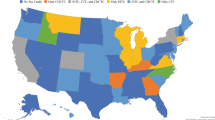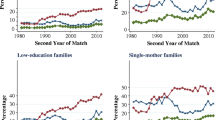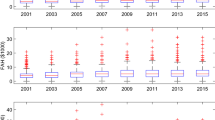Abstract
In this paper we investigate the relationship between income shocks and food insufficiency for U.S. households. Using Survey of Income and Program Participation data on U.S. households, we test the importance of both stable and transitory income components in determining food insufficiency. In a logistic regression model, we find that both the level of income and negative income shocks affect the predicted probability of food insufficiency, while positive income shocks do not. Although we do not have a definitive measure of a household’s liquidity constraint status, our work suggests that negative shocks may matter more for households that face liquidity constraints. Understanding the role of income shocks in determining food insufficiency is especially important in light of recent policy changes. It is likely that welfare reform in the U.S. increased the volatility of income in the low-income population. Our findings here suggest that this increase in volatility may not be without consequence.
Similar content being viewed by others
Notes
The Food Stamp program was renamed the Supplemental Nutrition Assistance Program (SNAP) in October 2008.
Here the stable portion of income is fixed. However, this framework can be generalized to allow for a stable trend component which reflects the age-earnings profile of household members or rising real earnings; we empirically test such a model in our sensitivity testing below.
The 36 months of interviews are actually conducted over 39 calendar months because each SIPP panel is divided into four rotation groups; one-quarter of the interviews are conducted in each calendar month.
The household head is the SIPP ‘reference person’—the person in whose name the home is owned or rented. If the house is owned jointly by a married couple, either the husband or the wife may be listed as the reference person. The household as the unit of analysis is most consistent with the concept of food deprivation put forth by the National Research Council (2006) in their assessment of such measures: “Food insecurity is measured as a household-level concept” (National Research Council 2006, p. 4).
The food insecurity measure was created by the Economic Research Service (ERS) of the USDA for the 2001 SIPP based on five questions in the Wave 8 Topical Module instead of on the standard six- or eighteen-point food insecurity scales used by the ERS. ERS has shown measures based on the latter scales to be reliable and minimally biased (Bickel et al. 2000).
Researchers have put forth several possible reasons for the finding that food insufficiency is predictive of health or nutritional status for adults but not for children: adults may protect the health status of children in their household by skipping meals themselves before depriving their children, or children may have a more robust safety net that includes subsidized meal programs at school, or food at friends houses.
In sensitivity testing, we also generate comparable results using alternative asset measures—either the actual data for months 24 or 36 or the interpolated data for month 32.
Alternatively, these equations could be estimated as probit functions (available from the authors); as noted by Allison (1999, p. 73), estimates based on probit specifications yield comparable results.
Tests for equality of coefficients are conducted using a Wald chi-square test (SAS version 9.2, SURVEYLOGISTIC procedure).
A SIPP ‘Z-type’ imputation is the case were an entire missing interview record for a respondent is replaced with actual data from another respondent who is matched on a variety of demographic characteristics.
In both specifications we also model income shocks as the mean income shock that occurs over the four-month period with little change in the result (results available from the authors).
We thank an anonymous referee for suggesting this approach. Further details of the first-stage panel regression are outlined in an Appendix available from the authors.
Marginal effects are based on Model 3 in Table 3 and (for continuous variables) are computed as dP/dX = P(1 − P) b L, where P is the probability of food insufficiency for a particular population, X is the independent variable of interest, and b L is the logistic coefficient estimate on the independent variable of interest (see Pindyck and Rubinfeld 1981, p. 299).
References
Allison, P. D. (1999). Logistic regression using the SAS system: Theory and applications. Cary, NC: SAS.
Bania, N., & Leete, L. (2009). Monthly household income volatility in the U.S., 1991/92 vs. 2002/03. Economics Bulletin, 29(3), 2096–2108.
Barrow, L., & McGranahan, L. (2000). The effects of the earned income tax credit on the seasonality of household expenditures. National Tax Journal, LIII(4, part 2), 1211–1243.
Bernell, S., Edwards, M., & Weber, B. (2006). Restricted opportunities, unfortunate personal choices, ineffective policies: What explains food insecurity in Oregon? Journal of Agricultural and Resource Economics, 31(2), 193–211.
Bickel, G., Nord, M., Price, C., Hamilton, W., & Cook, J. (2000). Guide to measuring household food security, revised 2000. Alexandria, VA: U.S. Department of Agriculture, Food and Nutrition Service.
Blank, R. M. (2006). What did the 1990s welfare reforms accomplish. In A. Auerbach, D. Card, & J. Quigley (Eds.), Public policy and the income distribution. New York: Russell Sage. Chap. 2.
Bloom, D., Farrell, M., & Fink, B. (2002). Welfare time limits: State policies, implementation, and effects on families. New York: Manpower Demonstration Research Corporation.
Blundell, R., & Pistaferri, L. (2003). Income volatility and household consumption: The impact of food assistance programs. Journal of Human Resources, 38(S), 1032–1050.
Bollinger, C., Gonzalez, L., & Ziliak, J. P. (2009). Welfare reform and the level and composition of income. In J. P. Ziliak (Ed.), Welfare reform its long-term consequences for America’s poor (pp. 59–103). Cambridge: Cambridge University Press.
Borjas, G. (2002). Food insecurity and public assistance. Journal of Public Economics, 88, 1421–1443.
Corcoran, M., Danziger, S., Kalil, A., & Seefeldt, K. (2000). How welfare reform is affecting women’s work. Annual Review of Sociology, 26(1), 241.
Corcoran, M., Heflin, C., & Siefert, K. (2007). Work trajectories, income changes and food insufficiency in a Michigan welfare population. Social Service Review, 81, 3–25.
Currie, J., & Grogger, J. (2001). Explaining recent declines in food stamp program participation (pp. 203–244). Brookings-Wharton papers on urban affairs.
Farrell, M., Fishman, M., Langley, M., & Stapleton, D. (2003). The relationship of earnings and income to food stamp participation: A longitudinal analysis. USDA Economic Research Service, E-FAN-03-011.
Gruber, J. (1997). The consumption smoothing benefits of unemployment insurance. The American Economic Review, 87(1), 192–205.
Gundersen, C., & Gruber, J. (2001). The dynamic determinants of food insufficiency. In M. S. Andrews & M. A. Prell (Eds.), Second food security measurement and research conference (Vol. II: Papers 2001). Washington, DC: Department of Agriculture, Economic Research Service.
Gundersen, C., & Oliveira, V. (2001). The food stamp program and food insufficiency. American Journal of Agricultural Economics, 83(4), 875–887.
Gundersen, C., & Ribar, D. (2005). Food insecurity and insufficiency at low levels of food expenditures. IZA discussion paper no. 1594.
Hacker, J. S., & Jacobs, E. (2008). The rising instability of American family incomes, 1969–2004 evidence from the panel study of income dynamics. EPI briefing paper, Economic Policy Institute, May 29 2008, briefing paper #212.
Hajivassiliou, V., & Ioannides, Y. (2007). Unemployment and liquidity constraints. Journal of Applied Econometrics, 22, 479–510.
Hamermesh, Daniel. (2004). Subjective outcomes in economics. Southern Economic Journal, 71(1), 1–11.
Haskins, R. (2001). Effects of welfare reform on family income and poverty. In R. Blank & R. Haskins (Eds.), The new world of welfare. New York: Russell Sage.
Hotz, V. J., & Scholz, J. K. (2003). The earned income tax credit. In R. Moffitt (Ed.), Means-tested transfer programs in the United States. Chicago: University of Chicago Press. A National Bureau of Economic Research conference report.
Huffman, S., & Jensen, H. (2003). Do food assistance programs improve household food security? Recent evidence from the United States. CARD working paper 03-WP 335. Center for Agricultural and Rural Development, Iowa State University.
Jappelli, T. (1990). Who is credit constrained in the U.S. economy? The Quarterly Journal of Economics, 105(1), 219–234.
Jensen, H. (2002). Food insecurity and the food stamp program. American Journal of Agricultural Economics, 84(5), 1215–1228.
Kornfeld, R. (2002). Explaining recent trends in food stamp program caseloads. Cambridge, MA: Abt Associates. Report submitted to the U.S. Department of Agriculture, Economic Research Service.
Loprest, P., & Zedlewski, S. (1999). Current and former welfare recipients: How do they differ? Assessing the new federalism. Washington, DC: The Urban Institute. Discussion Paper 99–17.
Moffitt, R., & Winder, K. (2003). The correlates and consequences of welfare exit and entry: Evidence from the three-city study. Three-city working paper 03-01. Baltimore: Johns Hopkins University. Available at http://www.jhu.edu/~welfare.
National Research Council. (2006). In G. Wunderlich & J. Norwood (Eds.), Food insecurity and hunger in the United States: An assessment of the measure. Panel to review the U.S. Department of Agriculture’s measurement of food insecurity and hunger. Committee on National Statistics, Division of Behavioral and Social Sciences and Education. Washington, DC: The National Academies Press.
Newman, C. (2006). The income volatility see-saw: Implications for school lunch. USDA, Economic research report no. ERR-23.
Pindyck, R., & Rubinfield, D. (1981). Econometric models and economic forecasts (2nd ed.). New York: McGraw-Hill.
Primus, W., Rawlings, L., Larin, K., & Porter, K. (1999). The initial impacts of welfare reform on the economic well-being of single-mother families with children. Working paper, Center on Budget and Policy Priorities.
Ribar, D. C., & Hamrick, K. (2003). Dynamics of poverty and food sufficiency. Electronic Report from the Economic Research Service, U.S. Department of Agriculture, Food Assistance and Nutrition Research, research report 36.
Rose, D. (1999). Economic determinants and dietary consequences of food insecurity in the United States. The Journal of Nutrition, 129, 517s–520s.
Rose, D., & Oliveira, V. (1997). Nutrient intakes of individuals from food insufficient households in the United States. American Journal of Public Health, 87, 1956–1961.
Rose, D., Gundersen, C., & Oliveira, V. (1998). Socio-economic determinants of food insecurity in the United States: Evidence from the SIPP and CSFII datasets. Food and Rural Economics Division, Economic Research Service, US Department of Agriculture. Technical bulletin no. 1869.
Sullivan, J., Turner, L., & Danziger, S. (2008). The relationship between income and material hardship. Journal of Policy Analysis and Management, 27(1), 63–81.
Vozoris, N., & Tarasuk, V. (2003). Household food insufficiency is associated with poorer health. The Journal of Nutrition, 133(1), 120–126.
Ziliak, J., Gundersen, C., & Figlio, D. (2003). Food stamp caseloads over the business cycle. Southern Economics Journal, 69(4), 903–919.
Acknowledgments
The authors thank Jessica Greene, Craig Gundersen, Kathryn Magnuson, Joe Stone, Parke Wilde, and two anonymous referees, as well as participants at the following workshops for their detailed and useful comments: April 2006 IRP-USDA Small Grants Workshop, October 2006 USDA RIDGE Conference, November 2006 National Poverty Center/ERS-USDA Conference on ‘Income Volatility and Implications for Food Assistance II’ and the Spring 2007 Oregon State University Contemporary Rural Issues Seminar. This work was partially funded by the University of Wisconsin—Institute for Research on Poverty/USDA Small Grants Program under Agreement Number: F184516. Additional funding provided by the National Poverty Center, University of Michigan. An earlier version of this work appeared as a working paper at the University of Wisconsin Institute for Research on Poverty (WP# 1325-07). All remaining errors are the responsibility of the authors, however. The views and opinions expressed herein are those of the authors and do not necessarily reflect those of the Food Assistance and Nutrition Research Program, the Economic Research Service, or the United States Department of Agriculture.
Author information
Authors and Affiliations
Corresponding author
Rights and permissions
About this article
Cite this article
Leete, L., Bania, N. The effect of income shocks on food insufficiency. Rev Econ Household 8, 505–526 (2010). https://doi.org/10.1007/s11150-009-9075-4
Received:
Accepted:
Published:
Issue Date:
DOI: https://doi.org/10.1007/s11150-009-9075-4




